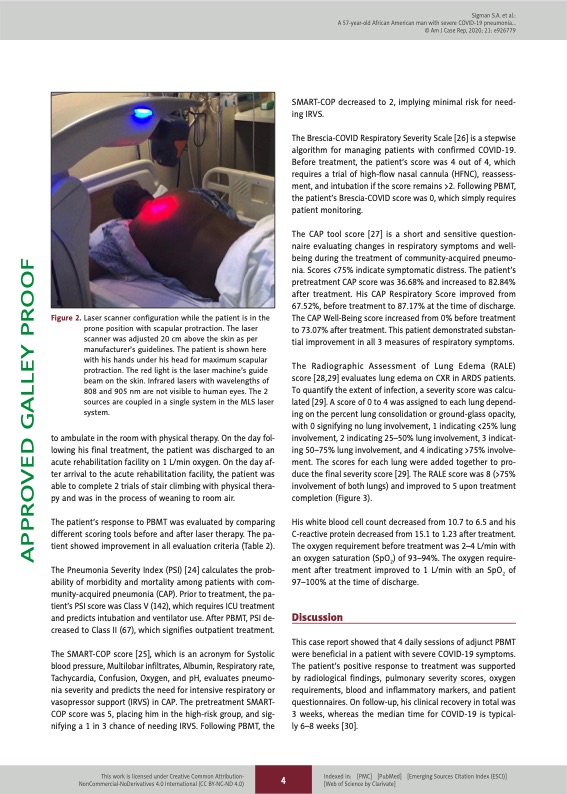
PDF Publication Title:
Text from PDF Page: 004
Sigman S.A. et al.: A 57-year-old African American man with severe COVID-19 pneumonia... © Am J Case Rep, 2020; 21: e926779 Figure 2. Laser scanner configuration while the patient is in the prone position with scapular protraction. The laser scanner was adjusted 20 cm above the skin as per manufacturer’s guidelines. The patient is shown here with his hands under his head for maximum scapular protraction. The red light is the laser machine’s guide beam on the skin. Infrared lasers with wavelengths of 808 and 905 nm are not visible to human eyes. The 2 sources are coupled in a single system in the MLS laser system. to ambulate in the room with physical therapy. On the day fol- lowing his final treatment, the patient was discharged to an acute rehabilitation facility on 1 L/min oxygen. On the day af- ter arrival to the acute rehabilitation facility, the patient was able to complete 2 trials of stair climbing with physical thera- py and was in the process of weaning to room air. The patient’s response to PBMT was evaluated by comparing different scoring tools before and after laser therapy. The pa- tient showed improvement in all evaluation criteria (Table 2). The Pneumonia Severity Index (PSI) [24] calculates the prob- ability of morbidity and mortality among patients with com- munity-acquired pneumonia (CAP). Prior to treatment, the pa- tient’s PSI score was Class V (142), which requires ICU treatment and predicts intubation and ventilator use. After PBMT, PSI de- creased to Class II (67), which signifies outpatient treatment. The SMART-COP score [25], which is an acronym for Systolic blood pressure, Multilobar infiltrates, Albumin, Respiratory rate, Tachycardia, Confusion, Oxygen, and pH, evaluates pneumo- nia severity and predicts the need for intensive respiratory or vasopressor support (IRVS) in CAP. The pretreatment SMART- COP score was 5, placing him in the high-risk group, and sig- nifying a 1 in 3 chance of needing IRVS. Following PBMT, the SMART-COP decreased to 2, implying minimal risk for need- ing IRVS. The Brescia-COVID Respiratory Severity Scale [26] is a stepwise algorithm for managing patients with confirmed COVID-19. Before treatment, the patient’s score was 4 out of 4, which requires a trial of high-flow nasal cannula (HFNC), reassess- ment, and intubation if the score remains >2. Following PBMT, the patient’s Brescia-COVID score was 0, which simply requires patient monitoring. The CAP tool score [27] is a short and sensitive question- naire evaluating changes in respiratory symptoms and well- being during the treatment of community-acquired pneumo- nia. Scores <75% indicate symptomatic distress. The patient’s pretreatment CAP score was 36.68% and increased to 82.84% after treatment. His CAP Respiratory Score improved from 67.52%, before treatment to 87.17% at the time of discharge. The CAP Well-Being score increased from 0% before treatment to 73.07% after treatment. This patient demonstrated substan- tial improvement in all 3 measures of respiratory symptoms. The Radiographic Assessment of Lung Edema (RALE) score [28,29] evaluates lung edema on CXR in ARDS patients. To quantify the extent of infection, a severity score was calcu- lated [29]. A score of 0 to 4 was assigned to each lung depend- ing on the percent lung consolidation or ground-glass opacity, with 0 signifying no lung involvement, 1 indicating <25% lung involvement, 2 indicating 25–50% lung involvement, 3 indicat- ing 50–75% lung involvement, and 4 indicating >75% involve- ment. The scores for each lung were added together to pro- duce the final severity score [29]. The RALE score was 8 (>75% involvement of both lungs) and improved to 5 upon treatment completion (Figure 3). His white blood cell count decreased from 10.7 to 6.5 and his C-reactive protein decreased from 15.1 to 1.23 after treatment. The oxygen requirement before treatment was 2–4 L/min with an oxygen saturation (SpO2) of 93–94%. The oxygen require- ment after treatment improved to 1 L/min with an SpO2 of 97–100% at the time of discharge. Discussion This case report showed that 4 daily sessions of adjunct PBMT were beneficial in a patient with severe COVID-19 symptoms. The patient’s positive response to treatment was supported by radiological findings, pulmonary severity scores, oxygen requirements, blood and inflammatory markers, and patient questionnaires. On follow-up, his clinical recovery in total was 3 weeks, whereas the median time for COVID-19 is typical- ly 6–8 weeks [30]. This work is licensed under Creative Common Attribution- NonCommercial-NoDerivatives 4.0 International (CC BY-NC-ND 4.0) 4 Indexed in: [PMC] [PubMed] [Emerging Sources Citation Index (ESCI)] [Web of Science by Clarivate] APPROVED GALLEY PROOFPDF Image | A COVID-19 Pneumonia Responded to Photobiomodulation Therapy

PDF Search Title:
A COVID-19 Pneumonia Responded to Photobiomodulation TherapyOriginal File Name Searched:
laser-therapy-severe-COVID-19-case.pdfDIY PDF Search: Google It | Yahoo | Bing
Cruise Ship Reviews | Luxury Resort | Jet | Yacht | and Travel Tech More Info
Cruising Review Topics and Articles More Info
Software based on Filemaker for the travel industry More Info
The Burgenstock Resort: Reviews on CruisingReview website... More Info
Resort Reviews: World Class resorts... More Info
The Riffelalp Resort: Reviews on CruisingReview website... More Info
| CONTACT TEL: 608-238-6001 Email: greg@cruisingreview.com | RSS | AMP |